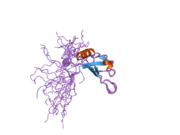
Nucleolin
| NCL | |||||||||||||||||||||||||||||||||||||||||||||||||||
|---|---|---|---|---|---|---|---|---|---|---|---|---|---|---|---|---|---|---|---|---|---|---|---|---|---|---|---|---|---|---|---|---|---|---|---|---|---|---|---|---|---|---|---|---|---|---|---|---|---|---|---|
 | |||||||||||||||||||||||||||||||||||||||||||||||||||
| |||||||||||||||||||||||||||||||||||||||||||||||||||
| Identifiers | |||||||||||||||||||||||||||||||||||||||||||||||||||
| Aliases | NCL, C23, nucleolin, Nsr1 | ||||||||||||||||||||||||||||||||||||||||||||||||||
| External IDs | OMIM: 164035 MGI: 97286 HomoloGene: 136488 GeneCards: NCL | ||||||||||||||||||||||||||||||||||||||||||||||||||
| |||||||||||||||||||||||||||||||||||||||||||||||||||
| |||||||||||||||||||||||||||||||||||||||||||||||||||
| |||||||||||||||||||||||||||||||||||||||||||||||||||
| |||||||||||||||||||||||||||||||||||||||||||||||||||
| |||||||||||||||||||||||||||||||||||||||||||||||||||
| Wikidata | |||||||||||||||||||||||||||||||||||||||||||||||||||
| |||||||||||||||||||||||||||||||||||||||||||||||||||
Nucleolin is a protein that in humans is encoded by the NCL gene.
Gene
The human NCL gene is located on chromosome 2 and consists of 14 exons with 13 introns and spans approximately 11kb. The intron 11 of the NCL gene encodes a small nucleolar RNA, termed U20.
Function
Nucleolin is the major nucleolar protein of growing eukaryotic cells. It is found associated with intranucleolar chromatin and pre-ribosomal particles. It induces chromatin decondensation by binding to histone H1. It is thought to play a role in pre-rRNA transcription and ribosome assembly. May play a role in the process of transcriptional elongation. Binds RNA oligonucleotides with 5'-UUAGGG-3' repeats more tightly than the telomeric single-stranded DNA 5'-TTAGGG-3' repeats.
Nucleolin is also able to act as a transcriptional coactivator with Chicken Ovalbumin Upstream Promoter Transcription Factor II (COUP-TFII).
Clinical significance
Midkine and pleiotrophin bind to cell-surface nucleolin as a low affinity receptor. This binding can inhibit HIV infection.
Nucleolin at the cell surface is the receptor for the respiratory syncytial virus (RSV) fusion protein. Interference with the nucleolin–RSV fusion protein interaction has been shown to be therapeutic against RSV infection in cell cultures and animal models.
Interactions
Nucleolin has been shown to interact with:
Further reading
- Tuteja R, Tuteja N (1999). "Nucleolin: a multifunctional major nucleolar phosphoprotein". Critical Reviews in Biochemistry and Molecular Biology. 33 (6): 407–36. doi:10.1080/10409239891204260. PMID 9918513.
- Pasternack MS, Bleier KJ, McInerney TN (Aug 1991). "Granzyme A binding to target cell proteins. Granzyme A binds to and cleaves nucleolin in vitro". The Journal of Biological Chemistry. 266 (22): 14703–8. doi:10.1016/S0021-9258(18)98743-0. PMID 1860869.
- Belenguer P, Caizergues-Ferrer M, Labbé JC, Dorée M, Amalric F (Jul 1990). "Mitosis-specific phosphorylation of nucleolin by p34cdc2 protein kinase". Molecular and Cellular Biology. 10 (7): 3607–18. doi:10.1128/MCB.10.7.3607. PMC 360797. PMID 2192260.
- Srivastava M, Fleming PJ, Pollard HB, Burns AL (Jun 1989). "Cloning and sequencing of the human nucleolin cDNA". FEBS Letters. 250 (1): 99–105. doi:10.1016/0014-5793(89)80692-1. PMID 2737305. S2CID 8690886.
- Tuteja N, Huang NW, Skopac D, Tuteja R, Hrvatic S, Zhang J, Pongor S, Joseph G, Faucher C, Amalric F (Jul 1995). "Human DNA helicase IV is nucleolin, an RNA helicase modulated by phosphorylation". Gene. 160 (2): 143–8. doi:10.1016/0378-1119(95)00207-M. PMID 7642087.
- Jordan P, Heid H, Kinzel V, Kübler D (Dec 1994). "Major cell surface-located protein substrates of an ecto-protein kinase are homologs of known nuclear proteins". Biochemistry. 33 (49): 14696–706. doi:10.1021/bi00253a007. PMID 7993898.
- Nicoloso M, Caizergues-Ferrer M, Michot B, Azum MC, Bachellerie JP (Sep 1994). "U20, a novel small nucleolar RNA, is encoded in an intron of the nucleolin gene in mammals". Molecular and Cellular Biology. 14 (9): 5766–76. doi:10.1128/mcb.14.9.5766. PMC 359102. PMID 8065311.
- Ishikawa F, Matunis MJ, Dreyfuss G, Cech TR (Jul 1993). "Nuclear proteins that bind the pre-mRNA 3' splice site sequence r(UUAG/G) and the human telomeric DNA sequence d(TTAGGG)n". Molecular and Cellular Biology. 13 (7): 4301–10. doi:10.1128/MCB.13.7.4301. PMC 359985. PMID 8321232.
- Eggert M, Möws CC, Tripier D, Arnold R, Michel J, Nickel J, Schmidt S, Beato M, Renkawitz R (Dec 1995). "A fraction enriched in a novel glucocorticoid receptor-interacting protein stimulates receptor-dependent transcription in vitro". The Journal of Biological Chemistry. 270 (51): 30755–9. doi:10.1074/jbc.270.51.30755. PMID 8530516. S2CID 25642912.
- Bharti AK, Olson MO, Kufe DW, Rubin EH (Jan 1996). "Identification of a nucleolin binding site in human topoisomerase I". The Journal of Biological Chemistry. 271 (4): 1993–7. doi:10.1074/jbc.271.4.1993. PMID 8567649. S2CID 25059254.
- Li YP, Busch RK, Valdez BC, Busch H (Apr 1996). "C23 interacts with B23, a putative nucleolar-localization-signal-binding protein". European Journal of Biochemistry. 237 (1): 153–8. doi:10.1111/j.1432-1033.1996.0153n.x. PMID 8620867.
- Li D, Dobrowolska G, Krebs EG (Jun 1996). "The physical association of casein kinase 2 with nucleolin". The Journal of Biological Chemistry. 271 (26): 15662–8. doi:10.1074/jbc.271.26.15662. PMID 8663258. S2CID 10750338.
- Zhou G, Seibenhener ML, Wooten MW (Dec 1997). "Nucleolin is a protein kinase C-zeta substrate. Connection between cell surface signaling and nucleus in PC12 cells". The Journal of Biological Chemistry. 272 (49): 31130–7. doi:10.1074/jbc.272.49.31130. PMID 9388266.
- Haluska P, Saleem A, Edwards TK, Rubin EH (Apr 1998). "Interaction between the N-terminus of human topoisomerase I and SV40 large T antigen". Nucleic Acids Research. 26 (7): 1841–7. doi:10.1093/nar/26.7.1841. PMC 147454. PMID 9512561.
- Borggrefe T, Wabl M, Akhmedov AT, Jessberger R (Jul 1998). "A B-cell-specific DNA recombination complex". The Journal of Biological Chemistry. 273 (27): 17025–35. doi:10.1074/jbc.273.27.17025. PMID 9642267. S2CID 24347735.
- Larrucea S, González-Rubio C, Cambronero R, Ballou B, Bonay P, López-Granados E, Bouvet P, Fontán G, Fresno M, López-Trascasa M (Nov 1998). "Cellular adhesion mediated by factor J, a complement inhibitor. Evidence for nucleolin involvement". The Journal of Biological Chemistry. 273 (48): 31718–25. doi:10.1074/jbc.273.48.31718. PMID 9822633. S2CID 8004314.
- Parada CA, Roeder RG (Jul 1999). "A novel RNA polymerase II-containing complex potentiates Tat-enhanced HIV-1 transcription". The EMBO Journal. 18 (13): 3688–701. doi:10.1093/emboj/18.13.3688. PMC 1171446. PMID 10393184.






